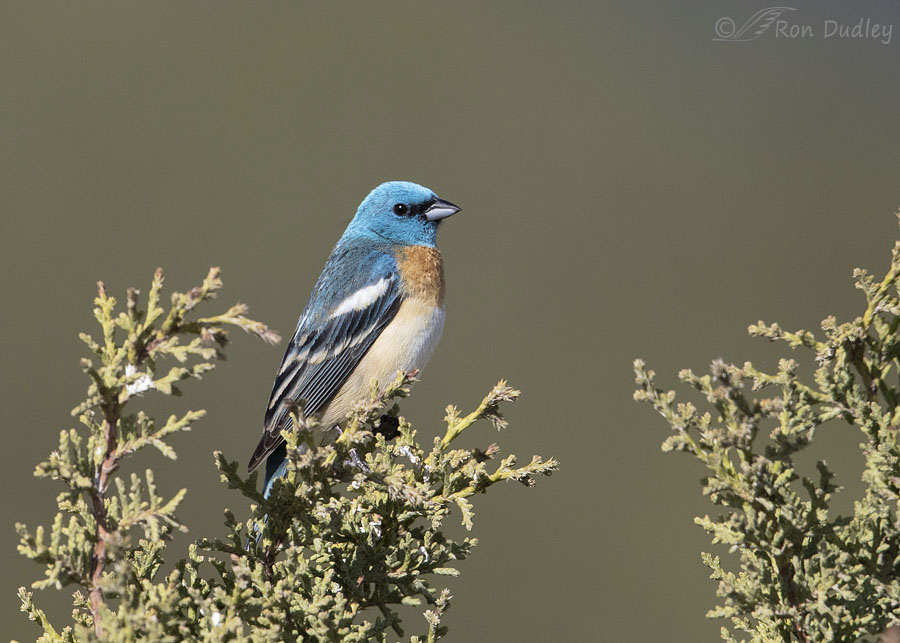Lazuli Buntings, males in particular, are conspicuous and well known in many western states. And they’re among the most beautiful birds I photograph.
A short post today.

1/3200, f/6.3, ISO 500, Canon 7D Mark II, Canon EF 500mm f/4L IS II USM + EF 1.4 III Extender, not baited, set up or called in
I found this male perched atop a juniper tree in Tooele County two days ago. Male Lazuli Buntings are known as persistent and conspicuous singers throughout the breeding season but I never did catch this guy breaking out into song. His brilliant colors had to do his singing for him.
It may not be a great photo in part because his tail is mostly hidden and some of the juniper leaves are a little out of focus.
But I think he’s a great bird.
Ron


Gorgeous creature … a bird I still hope to see in person in my lifetime. Since they prefer dry brushy habitats, you’d think my backyard would qualify!
Lovely description & image of these brilliant birds. There is no mistaking them: such bright colors! Never ever saw them growing up in MT, but now see them frequently in Eastern Oregon. Always a pleasure to watch these brightly colored friends. Thanks again, Ron!
Not sure if Dan will comment, but I think it was in his final year of teaching ornithology, that he had his class out on a nearby butte, climbing up toward the top (not intending to go that far) when they happened upon a male Lazuli Bunting doing a mating dance…right there on a trail! I can’t now recall his description, because alas, I wasn’t there that day, instead being at work, but in all Dan’s years of taking folks out birding, he had never seen this display, much less even heard of it! His students were very lucky that day!
OK Barbara, you’ve now inspired me to do a little research on that mating dance. I don’t remember hearing about them doing it.
Indeed! “Birds of the World” didn’t say much about the little dance he saw, so I’m not sure where or who would be out there that has described it! I’ll ask him to write and describe the movements since I wasn’t there!
He is gorgeous. And a bird I had not heard of, much less seen.
Thank you.
Thanks, EC.
This handsome bird definitely speaks volumes.
I agree.
Spectacular! Thanks for sharing.
Charlotte Norton
Thanks, Charlotte.
Been seeing them everyday on our feeders now for a few weeks. Such beautiful birds.
Lucky you, Bobbi.
I’ve seen two in my lifetime. They’re almost unreal in their beauty.
I hope you get to see more of them in the future, Catherine.
He glows in the sunrise. Wouldn’t you like to know what he looks like through another buntings eyes. Imagine the color they see!
Ha not sure my eyes could take much more color than this, April…
Not a bird in my area so I thoroughly enjoy everyone you post! A real beauty!
Good. Thanks, Kathy.
For yesterday’s post I was able to respond that I see hundreds of Violet-green Swallows, but for today I am sorry to say that I only once have seen a Lazuli Bunting. Posting him educated me too because I looked them up on Sibley’s to see their range and discovered that there are ten varieties of Buntings. Definitely did not know that.
Everett, writing this blog often sends me to the ‘look it up station’ too. I learn a lot of stuff that way.
They ARE beautiful…. We used to have an occasional one in spring apparently passing through. Been a few years…..
We used to have an occasional one in spring apparently passing through. Been a few years…..
Judy, I don’t believe I’ve ever seen them near Cut Bank.
I was oohing and aweing over the beauty of yesterday’s Violet-green Swallow. Here I am repeating that in spades with this stunning photo. Charming passerine, indeed.
BotW says “Remarkably,…dramatically more colorful males are still socially monogamous, with the males taking an active role in rearing the young.” Seems a rather anthropomorphic and chauvinist perspective.
“Seems a rather anthropomorphic and chauvinist perspective”
Lyle, but I suspect in the bird world it actually is remarkable….
All the various shades of this bird’s slate blue are beautiful.
Agreed.